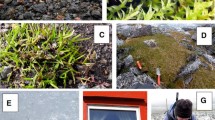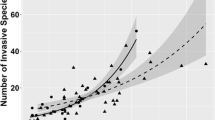Abstract
Tropical East Asia (TEA) has numerous islands, both continental and oceanic. This study uses information on invasive aliens in terrestrial habitats on these islands to test the generality of the continental-oceanic contrast in invasibility, assess the conservation impacts of invasive species, and suggest ways to mitigate these. The continental islands of Hong Kong and Singapore are worst-case scenarios for continental invasibility and alien species often dominate in chronically disturbed sites, but very few have successfully invaded closed forests, with the exception of birds in Hong Kong. On other, less densely populated, continental islands, closed-canopy forests appear to resist invasions by all taxa, with few known exceptions. Forests on oceanic islands isolated by <100 km during the last glacial maximum appear no more susceptible to plant and invertebrate invasions than those on continental islands, but invasions by mammals are widespread. Snake invasions may be under-recognized. The remote oceanic Ogasawara (Bonin) Islands, >1000 km from the nearest continent, have a native biota of largely tropical East Asian origin and are suffering from alien forest invasions across the taxonomic spectrum. These patterns of invasibility are consistent with the idea that alien invasion is facilitated by the absence of native species in the same functional group. Alien invasives are not yet a major conservation problem in TEA, except on remote islands, but their dominance on disturbed sites may slow or prevent recovery of native biodiversity. Strict quarantine is impractical in TEA, although some major introduction routes could be blocked. Management efforts should focus on early recognition and immediate control of potential problem species.

Similar content being viewed by others
References
Abe T (2006) Threatened pollination systems in native flora of the Ogasawara (Bonin) Islands. Ann Bot (Lond) 98:317–334. doi:10.1093/aob/mcl117
Abe T (2007) Predator or disperser? A test of indigenous fruit preference of alien rats (Rattus rattus) on Nishi-jima (Ogasawara Islands). Pac Conserv Biol 13:213–218
Abe T, Makino S, Okochi I (2008a) Why have endemic pollinators declined on the Ogasawara Islands? Biodivers Conserv 17:1465–1473. doi:10.1007/s10531-008-9355-y
Abe T, Wada K, Nakagoshi N (2008b) Extinction threats of a narrowly endemic shrub, Stachyurus macrocarpus (Stachyuraceae) in the Ogasawara Islands. Plant Ecol 198:169–183. doi:10.1007/s11258-007-9393-7
Ali R (2004) The effect of introduced herbivores on vegetation in the Andaman Islands. Curr Sci India 86:1103–1112
Ali R (2006) Issues relating to invasives in the Andaman Islands. J Bombay Nat Hist Soc 103:349–355
Baker N, Lim K (2008) Wild animals of Singapore: a photographic guide to mammals, reptiles, amphibians and freshwater fishes. Draco Publishing, Singapore
Balete DS, Heaney LR, Veluz MJ, Rickart EA (2009) Diversity patterns of small mammals in the Zambales Mts., Luzon, Philippines. Mamm Biol doi:10.1016/j.mambio.2008.05.006
Blackburn TM, Cassey P, Duncan RP, Evans KL, Gaston KJ (2004) Avian extinction and mammalian introductions on oceanic islands. Science 305:1955–1958. doi:10.1126/science.1101617
Bos MM, Tylianakis JM, Steffan-Dewenter I, Tscharntke T (2008) The invasive Yellow Crazy Ant and the decline of forest ant diversity in Indonesian cacao agroforests. Biol Invasions 10:1399–1409. doi:10.1007/s10530-008-9215-4
Brown WC, Alcala AC (1970) The zoogeography of the herpetofauna of the Philippine islands, a fringing archipelago. Proc Calif Acad Sci 38:105–139
Carrete M, Tella J (2008) Wild-bird trade and exotic invasions: a new link of conservation concern? Front Ecol Environ 6:207–211. doi:10.1890/070075
Chan SW (2007) Religious release of birds in Hong Kong. Dissertation, University of Hong Kong
Chiba S (2007) Species richness patterns along environmental gradients in island land molluscan fauna. Ecology 88:1738–1746. doi:10.1890/06-1735.1
Chung KPS, Corlett RT (2006) Rodent diversity in a highly degraded tropical landscape: Hong Kong, South China. Biodivers Conserv 15:4521–4532. doi:10.1007/s10531-005-5102-9
Corlett RT (1988) The naturalized flora of Singapore. J Biogeogr 15:657–663. doi:10.2307/2845443
Corlett RT (1992a) The ecological transformation of Singapore, 1819–1990. J Biogeogr 19:411–420. doi:10.2307/2845569
Corlett RT (1992b) The naturalized flora of Hong Kong—a comparison with Singapore. J Biogeogr 19:421–430. doi:10.2307/2845570
Corlett RT (2006) Conservation of biodiversity in a highly degraded landscape: problems and prospects. In: Jim CY, Corlett RT (eds) Sustainable management of protected areas for future generations. Friends of the Country Parks, Hong Kong, pp 77–92
Corlett RT (2009) The ecology of Tropical East Asia. Oxford University Press, Oxford
Crombie RI, Pregill GK (1999) A checklist of the herpetofauna of the Palau Islands (Republic of Belau), Oceania. Herpetol Monogr 13:29–80. doi:10.2307/1467060
Crooks JA (2005) Lag times and exotic species: the ecology and management of biological invasions. Ecoscience 12:316–329. doi:10.2980/i1195-6860-12-3-316.1
Daehler C (2006) Invasibility of tropical islands by introduced plants: partitioning the influence of isolation and propagule pressure. Preslia 78:389–404
Dawson W, Mndolwa AS, Burslem D, Hulme PE (2008) Assessing the risks of plant invasions arising from collections in tropical botanical gardens. Biodivers Conserv 17:1979–1995. doi:10.1007/s10531-008-9345-0
de Lang R, Vogel G (2005) The snakes of Sulawesi: a field guide to the land snakes of Sulawesi with identification keys. Edition Chimaira, Frankfurt am Main
Denslow JS (2003) Weeds in paradise: thoughts on the invasibility of tropical islands. Ann Mo Bot Gard 90:119–127. doi:10.2307/3298531
Denslow JS (2007) Managing dominance of invasive plants in wildlands. Curr Sci India 93:1579–1586
Dudgeon D, Corlett RT (2004) The ecology and biodiversity of Hong Kong. Joint Publishing, Hong Kong, China
Earl of Cranbrook, Payne J, Leh CMU (2008) Origin of the elephants Elephas maximus L. of Borneo. Sarawak Mus J 63(84):1–25
Fellowes JR (1999) Exotic ants in Asia: is the mainland at risk? Aliens 9:5–6
Flannery TF (1995) Mammals of the South West Pacific and Moluccan Islands. Reed, Sydney
Funk JL, Cleland EE, Suding KN, Zavalleta ES (2008) Restoration through reassembly: plant traits and invasion resistance. Trends Ecol Evol 23:695–703. doi:10.1016/j.tree.2008.07.013
Gordon DR, Onderdonk DA, Fox AM, Stocker RK (2008) Consistent accuracy of the Australian weed risk assessment system across varied geographies. Divers Distrib 14:234–242. doi:10.1111/j.1472-4642.2007.00460.x
Hata K, Suzuki JI, Kachi N, Yamamura Y (2006) A 19-year study of the dynamics of an invasive alien tree, Bischofia javanica, on a subtropical oceanic island. Pac Sci 60:455–470. doi:10.1353/psc.2006.0029
Herben T (2005) Species pool size and invasibility of island communities: a null model of sampling effects. Ecol Lett 8:909–917. doi:10.1111/j.1461-0248.2005.00790.x
Howald G et al (2007) Invasive rodent eradication on islands. Conserv Biol 21:1258–1268. doi:10.1111/j.1523-1739.2007.00755.x
Huang S-C, Norval G, Wei C-S, Tso I-M (2008) Effects of brown anole invasion and betelnut palm planting on arthropod diversity in southern Taiwan. Zool Sci 25:1121–1129. doi:10.2108/zsj.25.1121
Inger RF, Voris HK (2001) The biogeographical relations of the frogs and snakes of Sundaland. J Biogeogr 28:863–891. doi:10.1046/j.1365-2699.2001.00580.x
Karube H, Suda S (2004) A preliminary report on influence of an introduced lizard Anolis carolinensis on the native insect fauna of Ogasawara Islands. Res Rep Kanagawa Prefectural Mus Nat Hist 12:21–30
Kato M, Shibata A, Yasui T, Nagamasu H (1999) Impact of introduced honeybees, Apis mellifera, upon native bee communities in the Bonin (Ogasawara) Islands. Res Popul Ecol (Kyoto) 41:217–228
Kawakami K, Higuchi H (2002) Predation by domestic cats on birds of Hahajima Island of the Bonin Islands, southern Japan. Ornithol Sci 1:143–144. doi:10.2326/osj.1.143
Kwok HK (2007) Changes of a forest bird community in Hong Kong of China in 10 years. Acta Ecol Sin 27:3993–4001. doi:10.1016/S1872-2032(07)60085-7
Kwok HK, Corlett RT (1999) Seasonality of a forest bird community in Hong Kong, South China. Ibis 141:70–79. doi:10.1111/j.1474-919X.1999.tb04264.x
Leung GPC, Hau BCH, Corlett RT (2009) Exotic plant invasions in the highly degraded upland landscape of Hong Kong, China. Biodivers Conserv 18:191–202. doi:10.1007/s10531-008-9466-5
Leven MR, Corlett RT (2004) Invasive birds in Hong Kong, China. Ornithol Sci 3:43–55. doi:10.2326/osj.3.43
Lever C (2003) Naturalized reptiles and amphibians of the world. Oxford University Press, Oxford
Maeto K, Fukuyama K (2003) Vertical stratification of ambrosia beetle assemblage in a lowland rain forest at Pasoh, Peninsular Malaysia. In: Okuda T, Monokaran N, Matsumoto Y, Niiyama K, Thomas SC, Ashton PS (eds) Pasoh: ecology of a lowland rain forest in Southeast Asia. Springer-Verlag, Tokyo, pp 325–336
Meijaard E (2003) Mammals of south-east Asian islands and their Late Pleistocene environments. J Biogeogr 30:1245–1257. doi:10.1046/j.1365-2699.2003.00890.x
Messing RH, Wright MG (2006) Biological control of invasive species: solution or pollution? Front Ecol Environ 4:237. doi:10.1890/1540-9295(2006)004[0132:BCOISS]2.0.CO;2 237
Morley RJ (2003) Interplate dispersal paths for megathermal angiosperms. Perspect Plant Ecol 6:5–20. doi:10.1078/1433-8319-00039
Osunkoya OO, Othman FE, Kahar RS (2005) Growth competition between seedlings of an invasive plantation tree, Acacia mangium, and those of a native Borneo heath-forest species, Melastoma beccarianum. Ecol Res 20:205–214. doi:10.1007/s11284-004-0027-4
Pfeiffer M, Tuck HC, Lay TC (2008) Exploring arboreal ant community composition and co-occurrence patterns in plantations of oil palm Elaeis guineensis in Borneo and Peninsular Malaysia. Ecography 31:21–32. doi:10.1111/j.2007.0906-7590.05172.x
Rasingam L, Parthasarathy N (2009) Diversity of understorey plants in undisturbed and disturbed tropical lowland forests of Little Andaman Island, India. Biodivers Conserv. doi:10.1007/s10531-008-9496-z
Reaser JK, Meyerson LA, Von Holle B (2008) Saving camels from straws: how propagule pressure-based prevention policies can reduce the risk of biological invasion. Biol Invasions 10:1085–1098. doi:10.1007/s10530-007-9186-x
Sax DF, Gaines SD, Brown JH (2002) Species invasions exceed extinctions on islands worldwide: a comparative study of plants and birds. Am Nat 160:766–783. doi:10.1086/343877
Shimizu Y (2003) The nature of Ogasawara and its conservation. Glob Environ Res 7:3–14
Shimizu Y (2006) Population dynamics of an invasive plant (Psidium cattleianum) after two continuous disturbances in the Pinus-Schima secondary forest on Chichijima in the Ogasawara (Bonin) Islands. Reg Views 19:1–15
Simberloff D (1995) Why do introduced species appear to devastate islands more than mainland areas? Pac Sci 49:87–97
Simberloff D (2009) We can eliminate invasions or live with them. Successful management projects. Biol Invasions 11:149–157. doi:10.1007/s10530-008-9317-z
Simons A, Bulbeck D (2004) Late Quaternary faunal successions in South Sulawesi, Indonesia. Mod Quaternary Res Southeast Asia 18:167–190
Space JC, Waterhouse BM, Miles JE, Tiobech J, Rengulbai K (2003) Report to the Republic of Palau on invasive plant species of environmental concern. USDA Forest Service, Honolulu
Sugiura S, Yamaura Y (2009) Potential impacts of the invasive flatworm Platydemus manokwari on arboreal snails. Biol Invasions. doi:10.1007/s10530-008-9287-1
Sugiura S, Okochi I, Tamada H (2006) High predation pressure by an introduced flatworm on land snails on the oceanic Ogasawara Islands. Biotropica 38:700–703. doi:10.1111/j.1744-7429.2006.00196.x
Sugiura S, Tsuru T, Yamaura Y, Hasegawa M, Makihara H, Makino S (2008a) Differences in endemic insect assemblages among vegetation types on a small island of the oceanic Ogasawara Islands. Entomol Sci 11:131–141. doi:10.1111/j.1479-8298.2008.00263.x
Sugiura S, Yamaura Y, Makihara H (2008b) Biological invasion into the nested assemblage of tree-beetle associations on the oceanic Ogasawara Islands. Biol Invasions 10:1061–1071. doi:10.1007/s10530-007-9184-z
Tan HTW, Chou LM, Yeo DCJ, Ng PKL (2007) The natural heritage of Singapore. Prentice Hall, Singapore
Teo DHL, Tan HTW, Corlett RT, Wong CM, Lum SKY (2003) Continental rain forest fragments in Singapore resist invasion by exotic plants. J Biogeogr 30:305–310. doi:10.1046/j.1365-2699.2003.00813.x
Tilman D (2004) Niche tradeoffs, neutrality, and community structure: a stochastic theory of resource competition, invasion, and community assembly. Proc Natl Acad Sci USA 101:10854–10861. doi:10.1073/pnas.0403458101
van den Bergh GD, Meijer HJM, Due Awe R, et al. (2008) The Liang Bua faunal remains: a 95 kyr sequence from Flores, East Indonesia. J Hum Evol. doi:10.1016/j.jhevol.2008.08.015
Van Driesche R, Hoddle M, Center T (2008) Control of pests and weeds by natural enemies: an introduction to biological control. Blackwell Publishing, Malden
Wang LK, Hails CJ (2007) An annotated checklist of the birds of Singapore. Raffles Bull Zool 15(Suppl):1–179
Watari Y, Takatsuki S, Miyashita T (2008) Effects of exotic mongoose (Herpestes javanicus) on the native fauna of Amami-Oshima Island, southern Japan, estimated by distribution patterns along the historical gradient of mongoose invasion. Biol Invasions 10:7–17. doi:10.1007/s10530-007-9100-6
Wells K, Kock D, Lakim MB, Pfeiffer M (2006) Is Rattus rattus invading the primary rainforest on Borneo? Malay Nat J 59:73–79
Yamashita N, Tanaka N, Hoshi Y, Kushima H, Kamo K (2003) Seed and seedling demography of invasive and native trees of subtropical Pacific islands. J Veg Sci 14:15–24
Acknowledgments
I would like to thank the following people for assistance, information, ideas, and inspiration: Aidia Chan, David Dudgeon, John Fellowes, Nina Ingle, David Lane, Mike Leven, Hugh Tan, Ng Sai-chit, and Laura Wong.
Author information
Authors and Affiliations
Corresponding author
Rights and permissions
About this article
Cite this article
Corlett, R.T. Invasive aliens on tropical East Asian islands. Biodivers Conserv 19, 411–423 (2010). https://doi.org/10.1007/s10531-009-9624-4
Received:
Accepted:
Published:
Issue Date:
DOI: https://doi.org/10.1007/s10531-009-9624-4




